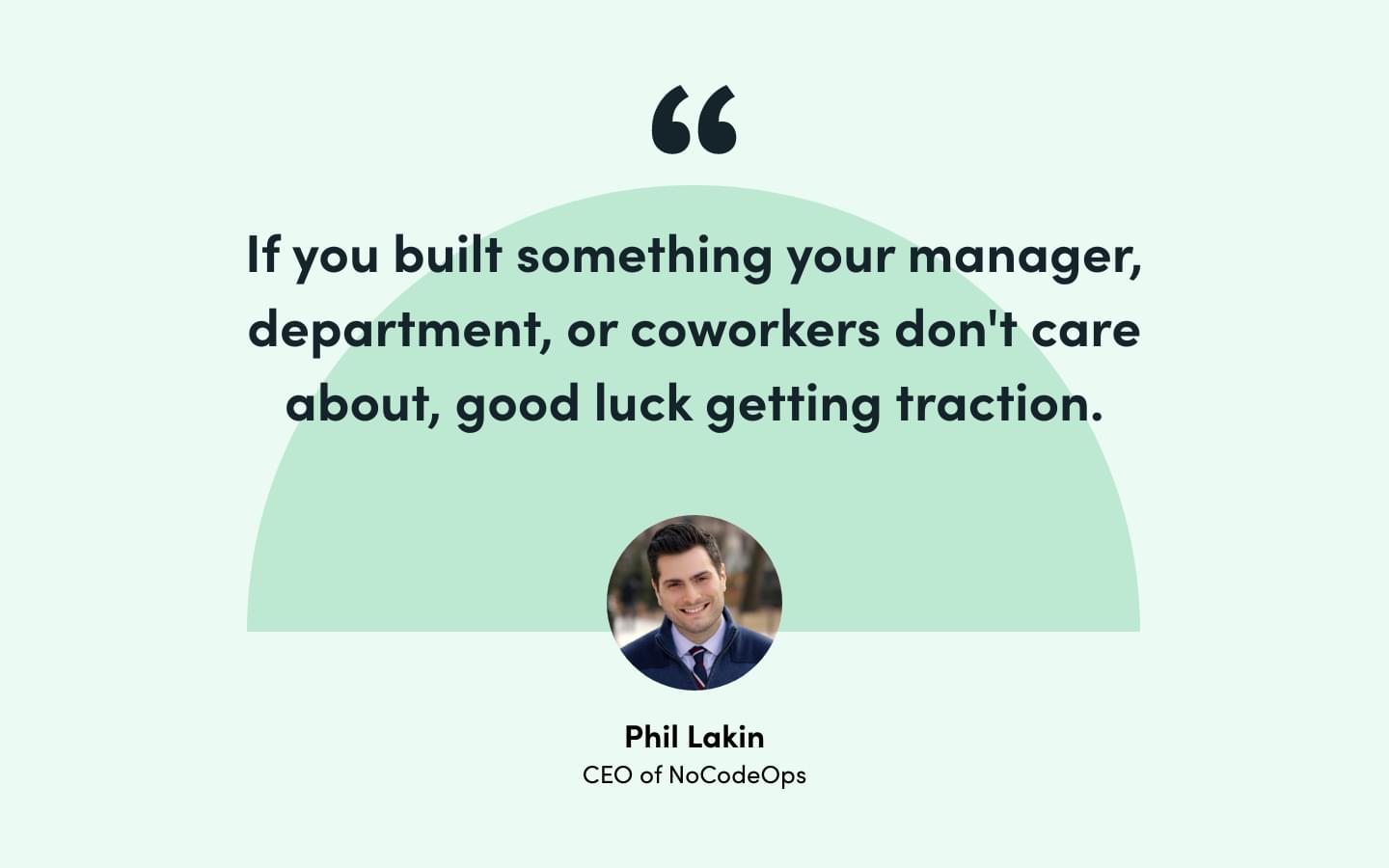Have you recently joined the no-code movement?
Welcome! I’m glad you’re here. As a lover of no-code tools myself, I’m always happy to see others discover the power of these tools. Isn’t the feeling of spinning something up in a matter of moments just amazing?
I could go on, but if you’ve recently demoed or trialed a no-code tool, you already know what I’m talking about. So next thing’s next: How do you go about getting buy-in, budget, and approval for this magical no-code tool you’ve discovered?
Luckily for you, Phil Lakin has the answer. He recently joined me on an episode of Formstack’s Practically Genius podcast to explain. Below, I share his best secrets on gathering leadership buy-in for no-code tools.

Listen Now: If you’d rather hear Phil explain his tactics, you can listen to his episode, Move from Inspiration to Impact Faster with No-Code. Here’s a snippet where he describes the powerful journey no-code can lead people on:
Step 1: Choose a single problem to solve.
You’ve just discovered an incredibly powerful no-code tool that you think can solve tons of problems within your department. That’s great! But to get your manager or senior leaders on board, you’ll need to choose a single problem to solve with the tool first. This will improve your odds of convincing the buying committee to invest in the solution.
But how do you go about deciding on which problem to solve or use case to tackle? Phil suggests you “talk to your manager and see what some challenges are that aren't being solved by your technical team. Talk to your fellow staff and find out what those are.”
The best way to get buy-in (for anything) is to solve a single problem or pain point that impacts the most people. Chat with your team, coworkers in your department, and your manager to discover what process, workflow, or issue is the most difficult, cumbersome, or time-consuming. When you start small, and tackle something others really care about, you’re much more likely to get support and approval. “If you built something your manager, department, or coworkers don't care about, good luck getting traction,” Phil said.

Oh, and there’s another benefit of following Phil’s method: “If you get time to come up with some solutions, you'd be very surprised how fast promotions come after that.”
Related: 3 Crucial To-Dos Before Beginning a Project
Step 2: Identify goals, outcomes, and ROI.
Let’s be real—leadership cares most about the ROI and end results. If you don’t identify the goals, outcomes, and KPIs related to the no-code tool you want to bring on board, your pitch to leadership is likely to fall flat.
When pitching a new tool, we often get caught up focusing on the features. But what will truly make an impact is pointing out the potential ROI. Once you’ve picked a single problem to solve, identify possible outcomes and improvements that could result from using the new tool.
The exact ROI and outcomes will depend on the tool you’re using and what it’s replacing, but here are some no-code benefits you could consider:
- Improving access to data across teams
- Saving money by replacing multiple tools with one system
- Increasing customer and/or employee satisfaction through digitization
- Limiting reliance on IT, engineering, and/or DevOps
- Gaining back hours of employee time through automation
The most important part of this step is to be clear on the goal of the new tool and the expected outcomes. Some of the outcomes may have to be projections, but putting in the work to identify the ROI upfront will do wonders for proving the importance and impact of the no-code tool you’ve discovered.

Step 3: Start a free trial.
Now comes the exciting part: It’s time to build!
If you’ve already started a free trial of the no-code tool you want your organization to adopt, you may need to have your trial extended. Simply ask the sales rep on your account if this is possible—it’s not unusual to get an extension of a week or two if needed.
Once your trial account is up and running, it’s time to put in some work. Build out a minimal viable product (MVP) that can solve the problem that’s frustrating your team, manager, or department. You may not have a lot of time to work on this prototype, so focus on the core aspects that are most important to your organization and the process or workflow.
Once you’ve built out a test version of your solution, consider having a colleague or two test it out. Phil finds it incredibly helpful to gather buy-in at this level from potential users. “I think it's important to involve other stakeholders from the community of users that are eventually going to use the product every day. I've found that users internally don't like just being told, ‘here's the tool, now you have to use it.’” During this test phase, you can also gather feedback on how to improve your prototype, as well as glowing testimonials you can provide to leadership.
Pro Tip: Using a single tool across multiple departments is a great way to improve cross-departmental communication and collaboration, which is usually a high priority for senior leaders. Consider connecting with a few colleagues in other departments to see if they have potential use cases for the no-code tool you’re pitching.
Step 4: Do a show-and-tell.
Think you’re preparing to do yet another PowerPoint presentation? Think again!
The magic of no-code tools is that they allow you to spin up a solution quickly and easily. And it’s one you can literally show your senior leaders in real time. But it gets even better: After showing off your MVP, you can ask for feedback and make edits on the spot.
That is powerful! “You want to make a change? Let's do it together and show you how fast that could go,” Phil said. “That's what gets people excited. I remember we literally signed a six-figure contract for SaaS at Compass because the VP saw what we had built.”
Once you’ve garnered buy-in from senior management or the executive team, it’s time to start working on the rest of the organization. This might sound overwhelming, but Phil breaks it down into a pretty easy process:
As stated earlier, it’s important to gather support from the actual users of the product, not just senior leaders who hold budgetary approval. By running a pitch fest or demo day, you can get your MVP in front of real users and easily gather their feedback, thoughts, and (hopefully) buy-in. It may seem risky to show off other solutions, but as Phil pointed out, it will be for the greater good of everyone because, ultimately, the best tool will win.
Go Forth and Gather Buy-In for No-Code Now
Hopefully you feel prepared to gather buy-in for no-code at your organization thanks to the tips, tricks, and suggestions above. As Phil says, “No-code makes the impossible possible.” You probably already know this, and now is the time to show everyone else.
Phil has used no-code to solve a variety of problems throughout his career, propelling him into bigger and better roles every time. You can do the same! Learn how by listening to his episode Move from Inspiration to Impact Faster with No-Code.











